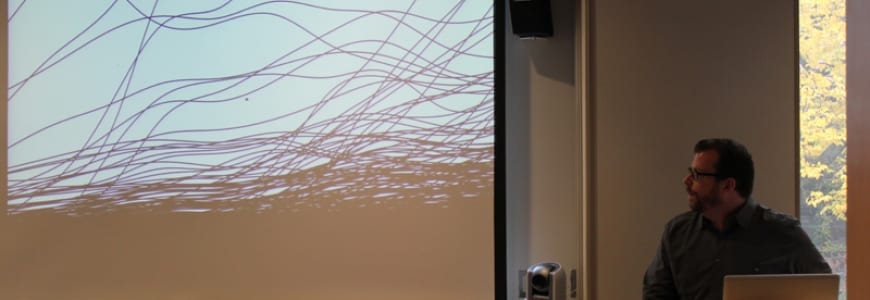By Rob Mitchum // November 7, 2013
On November 1st, the Computation Institute and the Center for Research Informatics invited University of Chicago students to eat lunch and hear about opportunities for research at UChicago and Argonne. Nine speakers gave “lightning talks” of less than 8 minutes on computational work in medicine, chemistry, climate and energy, social science, art and beyond, then students browsed posters from research centers affiliated with the CI and CRI. You can watch most of the lightning talks below, and view the posters presented during the reception. If you are interested in working with any of the researchers, contact them via the e-mail address on their directory page or write to rmitchum@ci.uchicago.edu.
Ian Foster, Computation Institute
Besides introducing attendees to the Computation Institute, Foster described Globus and The Discovery Cloud — his vision for bringing the power of large computational infrastructure to individual laboratories and researchers. Unfortunately, technical difficulties prevent us from sharing the video of Foster’s talk, but you can view/download the Globus poster here.
Sam Volchenboum, Center for Research Informatics, Computation Institute, ITM
The Center for Research Informatics is the home for biomedical informatics at the University of Chicago. Volchenboum, the director of the center and a pediatric oncologist, talked about projects in genomics, cancer research, and bioinformatics, and the types of work that the CRI supports. You can view/download posters on the CRI here and their Clinical Research Data Warehouse here.
Mike Papka, Argonne Computing, Environment and Life Sciences
Argonne National Laboratory is a Department of Energy Laboratory in suburban Chicago, and is one of the leading computational centers in the United States. Papka introduced the audiene to the Argonne Leadership Computing Facility, home of Mira — currently the world’s fifth-fastest supercomputer — and researchers pushing the boundaries of high-performance computing, software and data visualization.
Jason Salavon, Computation Institute & UChicagoArts
Computation isn’t just a tool for scientific research, it can also be a vehicle for artistic expression. CI fellow Jason Salavon demonstrated a couple examples of his computation-enabled artwork, including a piece for the lobby of the U.S. Census Bureau headquarters and composite photos of every Playboy centerfold published over four decades. For more on Salvon’s work, visit his website or learn about his new Hack Arts Lab at the University of Chicago.
Alison Brizius, Center for Robust Decision Making on Climate and Energy
As humanity confronts the spectre of dramatic climate change, scientists are building computer models to better simulate future climate changes and their effect upon the planet and the economy. At RDCEP, geophysicists, economists, statisticians, policy experts and computer scientists come together to improve these models and create better tools that policymakers can use to make important decisions about an unprecedented future. You can view the RDCEP poster here, or visit their website.
James Evans, Knowledge Lab and the Metaknowledge Research Network
Today, we have access to more information than ever before: text, images, videos and more. The Knowledge Lab is using this explosion of information to understand how knowledge is accumulated and to figure out ways to make knowledge better. James Evans, director of Knowledge Lab, talks about the group’s first wave of projects, such as using Google Maps images to assess neighborhood features. You can view the Knowledge Lab poster here.
Allison Heath, Bionimbus Protected Data Cloud
The Open Science Data Cloud is applying the power of cloud computing to scientific research using large datasets, including satellite data from NASA and cancer genomics. The new Bionimbus Protected Data Cloud, a HIPAA-compliant biomedical research cloud, allows approved researchers to access data from The Cancer Genome Atlas and the 1000 Genomes Project. Allison Heath describes these projects and the opportunities for students and researchers. The OSDC’s poster is available here.
Kate Keahey, Argonne National Laboratory
Sensors are becoming an integral part of science, collecting huge amounts of information about the world, from the ocean to city streets to the upper atmosphere. To make sense of these immense datasets requires flexible and scalable computational infrastructure, which Kate Keahey is working on with her Nimbus project. Keahey discussed her “infrastructure-as-a-service” research taking place at Argonne, and how students can get involved.
Additional Posters
While they didn’t have speakers at the November 1st event, the Urban Center for Computation and Data and the Swift group presented posters as part of the reception. View/download the UrbanCCD poster here, and the Swift poster here.

